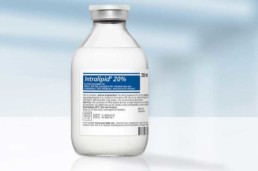Just facts and figures……
Intralipid infusion therapy is based on a blend of soya oil, egg yolk and glycerine and is thought to protect the cell membranes from the natural cell killers’ attacks. It is usually provided in tandem with IVF or IUI rather than as an alternative. It is a relatively low cost therapy, with no side effects that could increase success rates for women who have experienced implantation failures or early miscarriage/s.
When are Intralipids Taken?
It is administered through an IV 4-7 days before embryo transfer or insemination.
How does it help fertility and embryo implantation?
Natural killer cells are regulated by the immune system. In women who have autoimmune issues, the natural killer cells can react abnormally to an implanting embryo, treating it as an invading cell and signalling for the body to attack it. Studies have found that intralipids can help to deactivate the natural killer cells, allowing the embryo to implant on the uterine wall and grow normally. Intralipids are re-administered 4-5 weeks following a positive pregnancy test, to keep the natural killer cells deactivated until the pregnancy can override the signals being sent by the immune system.
Evidence is limited but research goes back decades, here are a few examples:
In 47 patients the suppressive effect of the Intralipid after the normalization of NKa lasted between 6 and 9 weeks, in two patients this benefit lasted 5 weeks, and in one patient the effect was 4 weeks.
Background: In vitro investigations have revealed the ability of intralipids to suppress natural killer (NK) cytotoxicity. Evidence from both animal and human studies suggests that intralipid administered intravenously may enhance implantation and maintenance of pregnancy when the patient has an abnormal NK cell level or function.
Problem: The aim of this study was to establish the duration and efficacy of Intralipids suppressive effect on NK cell functional activity.
Method of study: Fifty patients with abnormal NK activity results (NKa) received intralipid 20% i.v. (9 mg/mL total blood volume -corresponds to 2 mL of intralipid 20% diluted in 250 mL saline; or 18 mg/mL – corresponds to 4 mL of intralipid 20% diluted in 250 mL saline) infusions and their NKa were tested periodically. The determination of NK cell function was performed by flow cytometry using K562 cells as targets.
Results: Fifty women with abnormal NKa-testing received intralipid infusions. 39 (78%) showed NKa suppression within the normal range the first week after infusion, 11 (22%), showed suppression, but still above the normal threshold. They received second infusion 2-3 weeks later. In 10, the Nka activity was normalized the following week. Four patients had three intralipid infusions in 2-week periods in between and after the third infusion, and all showed NKa normal activity. In 47 patients the suppressive effect of the Intralipid after the normalization of NKa lasted between 6 and 9 weeks, in two patients this benefit lasted 5 weeks, and in one patient the effect was 4 weeks.
Conclusion: Intralipid is effective in suppressing in vivo abnormal NK-cell functional activity. The results suggest that Intralipid can be used successfully as a therapeutic option to modulate abnormal NK activity in women with reproductive failure.
Duration of intralipid’s suppressive effect on NK cell’s functional activity.
Roumen G Roussev, Brian Acacio, Siu C Ng, Carolyn B Coulam
Or, look at the below more recent studies:
Does intravenous intralipid treatment for reproductive failure enhance live births? The answer to this question is yes, BUT only in patients that have a diagnosis of recurrent implantation failure (RIF) or recurrent pregnancy loss (RPL) loss AND demonstrate elevated NK (natural killer) cell density in their endometrial biopsy. Live birth rates have been reported between 33% and 42% among women displaying elevated NK activity with a diagnosis of RIF and 75% and 91% among women experiencing RPL after intralipid infusion. When the pregnancy outcomes of women with a history of reproductive failure and elevated NK cells treated with intralipid were evaluated, the overall live birth rate per cycle of treatment was 61%. The results of published studies suggest that intralipid can be used successfully as a therapeutic option to modulate abnormal NK activity in women with reproductive problems.
Decisions on whether to give Intralipid and/or IVIg are based on NK assay (Natural Killer Cell testing) results, the severity of immune issues and the patient’s preferences. We commonly give the first infusion 7-14 days before a planned embryo transfer/implantation, followed by subsequent infusions on a positive pregnancy test and first ultrasound scan. The duration and timing of further infusions during pregnancy are made on the basis of the severity of immune issues, the results of NK retesting and your own preferences.
Intralipid treatment for women with reproductive failures.
Carolyn B. Coulam
Talk to your doctor, then talk to us – one of our ‘Nurse at Home’ nurses can administer your infusion at home.

